My first encounter with the bearded reedling (Panurus biarmicus) was during an excursion to the Tetjehorn nature reserve in the north of the Netherlands. Or at least my acquaintance with the sound these birds produce. Our guide Jan Glas had brought two gin glasses. It was still very early in the morning, so many participants on the excursion wondered if it was not a bit too early for a drink. But it soon became clear what Jan was planning with these glasses. He held them between his fingers and let the cups touch each other. The result sounds like a bell and is somewhat like the call of the bearded reedling. That is often the first thing you notice about this bird. First you hear it and then, sometimes after a lot of patience, you may catch a glimpse.
Flevoland
The bearded reedling is a typical bird of extensive reed beds. Preferably with a lot of young reeds. Suspended between some reed stems the reedling builds its nest and expertly assembles it from stems and leaves of reeds and other plants. Bearded reedlings can raise three to four broods per year, with four to seven eggs each. It is quite a job to hatch them and feed the young, therefore the female and male reedling do this together. This way, up to twenty young bearded reedlings can be raised per year. Until the first half of the last century, the bearded reedling was a rare breeding bird in the Netherlands. In the first years after the reclamation of Flevoland, large reed marshes arose there, a habitat where the bearded reedling feels very much at home.
Population pressure
The number of bearded reedlings increased explosively to an estimated 7,000 breeding pairs in the Netherlands in the mid-1970s. At that time, however, the further development of Flevoland also started and the extensive reed fields had to make place for arable farming and cities such as Lelystad and Almere. The population of the bearded reedling plummeted and between 1987 and 1995 the estimated number of breeding pairs in the Netherlands fluctuated between 300 and 1700. Partly due to the creation of ‘new nature’, this number recovered somewhat and is now estimated at 1750-2050 pairs. Incidentally, the explosive growth of the population in the 1970s resulted in an overpopulation of bearded reedlings, – of course – especially in Flevoland. As a result, these bearded reedlings spread across Western and Central Europe in the following years.
Reed tit
The bearded reedling owes its name to the two black beard stripes on the male, actually more like a drooping moustache than a beard. The male also has a beautiful grey head. Otherwise, both the male and the female are orange-brown in colour. They also have a long tail, which makes the bearded reedling look a bit like a long-tailed tit (Aegithalos caudatus) but the less common Eurasian penduline tit (Remiz pendulinus) is also very similar. It is not surprising that the bearded reedling is also called bearded tit. And just like the long-tailed tit and the penduline tit, the bearded reedlings are also distantly related to the great tit (Parus major) and blue tit (Cyanistes caeruleus). The bearded reedling, however, is taxonomically a separate family Panuridae within the superfamily of the small songbirds (Sylvioidea) and is the only species within this family. Also the families to which the other aforementioned species belong all fall under that superfamily Sylvioidea.
Two-sided decorated long tail
This strange description arises when you analyse the scientific name of the bearded reedling. The genus name Panurus refers to the bird’s long tail, almost as long as the body. In this case, this name is taken from the Greek, by a combination of pan-, which means ‘whole’, and -ouros, which means ‘tail’. When coming up with the genus name biarmicus, Linnaeus thought of the black beard stripes. It almost certainly comes from the Latin bi-, as in twice, and -arma, which stands for equipment, combined it gives something in the sense of “decorated on both sides”. And all of that together you come to a two-sided decorated long tail 🙂
Stone eaters
A characteristic common to all those tits is their fine, short beak. They are all real insectivores. In winter, however, insects are lacking, in any case there are insufficient to get through the cold period. That is why they switch to a vegetarian menu and the bearded reedlings eat the seeds of the reed. Seeds are harder to digest than insects and birds do not have teeth to grind the seeds. Therefore, in the winter months you can often see bearded reedlings sitting in groups on a gravel path, diligently looking for gravel. They eat the small stones, which then work in their gizzard like mill stones and ensure that the hard seeds are finely ground. The gizzard is an organ preceding the stomach, in which the food is reduced by kneading.
Gastrolith
While this behaviour is often attributed to bearded reedlings, they are not the only bird species to do so. Many other seed-eating bird species (such as finches and sparrows) also use little stones to grind the seeds in their gizzard. People who keep chickens will agree. There is even a term for these stones, namely gastrolith. Why this behaviour is often mentioned in the same breath with bearded reedlings is not clear to me. Maybe because it stands out with these birds? Our great tits and blue tits in the garden, for example, do this, they also depend on seeds in the winter and will therefore eat stones. Perhaps the great tits and blue tits do this less often or they also need it less because they also have soft bird food available in the gardens. By the way, carnivorous birds also do this, as this video shows of a peregrine falcon (Falco peregrinus). And the phenomenon also occurs in lions and crocodiles, among others. Since they do not chew, but swallow chunks of meat straight away, this will help them digest the meat and bones.
Adjusted gizzard
Bearded reedlings also have another aid to better digest the hard seeds. They adapt their gizzard to this diet. In summer months, their gizzard is surrounded by a flaccid muscle. The protein-rich insects are easily digested by the gastric juices, so there is no need for a lot of kneading. In autumn, however, that flaccid muscle changes its structure and becomes hard and firm, so that the gizzard contents can be properly kneaded. As soon as it gets warmer, the gizzard muscle weakens again. This trick has a downside, because they can only apply it once per season. A sudden early cold in the fall or a late frost after a relatively warm period at the beginning of the year can kill a lot of insects. If the gizzard of the bearded reedling is still (or already in the spring) in the ‘insect mode’, it has no way to digest the seeds on which it depends then. Certainly with a considerable period of frost after a few warmer weeks in spring, quite a few bearded reedlings can die. It is not without reason that they can raise up to twenty young per pair per year. In this way, they absorb such setbacks, among other things.
When you walk past a reed bed, pay attention to whether you hear gin glasses tinkling. And if you hear them and wait long enough, you might just come face to face with these beautiful reed tits.
Sources (in Dutch):



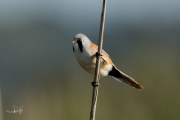
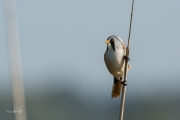
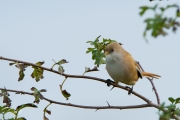
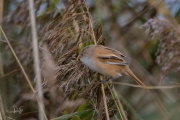

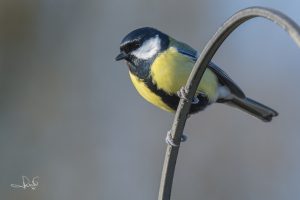
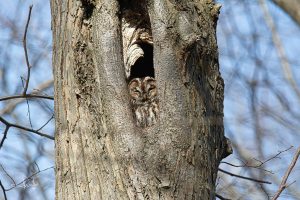
The seed grinding aided by grit happens in the gizzard, not the stomach or intestine.
Thank you for your addition, Bill. I have corrected it in the article.
Hallo, ik lees net dit stukje over de bearded tit en het is eind mei 2021. Volgens mij hebben wij deze vogels hier langs de zij stromingen van het Oldambtmeer. Dank u wel voor een heel duidelijk uitleg van type, habitat en digestive system. Indrukwekkend.
Dank je Lindy en graag gedaan :-). Dat zou zomaar kunnen dat daar baardmannetjes zitten.
heel mooi
Dank je Anita!
A very captivating description of a beautiful bird.
Thank you very much!
Very impressive. Now I can never looked at this curious reedling the same , learned a lot about it . Thank you
Thanks for your compliments Haroon. You’re welcome!